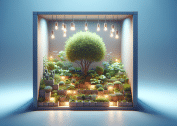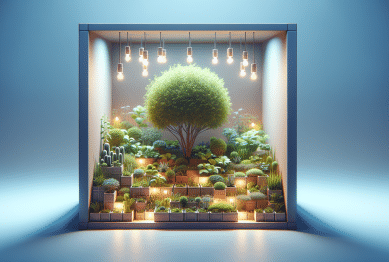Explore practical strategies for thriving houseplants with this in-depth guide to indoor plant care. Learn how you can maintain a lush, healthy home environment with insights on watering, lighting, humidity, pest prevention, and pet safety for houseplants.
Understanding Indoor Plant Needs for Healthy Growth
Maintaining the perfect home garden environment starts by understanding the essential needs of your indoor plants. Indoor plant care involves more than simply watering occasionally—balancing light, humidity, temperature, and soil conditions all play a significant role. Different houseplants come with unique requirements; for example, succulents prefer drier soil while ferns thrive on humidity. Research can reveal the best growing practices for your specific plants, setting the stage for resilient foliage and vibrant blooms. Recognizing early signs of distress, like yellow leaves or drooping stems, can be especially helpful for beginners. Having a good grasp of these basics leads to happy, thriving plants that naturally improve indoor air quality and aesthetics.
Light is a critical but often misunderstood component of houseplant health. Some houseplants demand bright, indirect sunlight while others, like snake plants, can tolerate deeper shade. Assessing each room in your home for natural light at various times of day allows you to match the right plant to the right place. Using artificial grow lights is another option for spaces with minimal natural illumination. Experimenting with positioning can boost leaf development and flower production, turning dull corners into vibrant indoor jungles.
Watering schedules can feel confusing, especially with so many factors influencing how quickly soil dries. The key is to avoid a one-size-fits-all routine. Instead, check soil moisture with your finger or a moisture meter before watering, and get to know the specific needs of your collection—overwatering is a top cause of root rot and plant decline. With observation and small adjustments, plants can flourish for years, turning a living space into a green retreat.
Lighting Solutions for Every Home Environment
Lighting challenges are common for indoor gardeners, but simple solutions can make a noticeable difference. Understanding the light requirements for popular houseplants—such as pothos, peace lilies, and philodendrons—is a first step. Windows facing east tend to offer gentle, filtered light ideal for low-light species, while bright, unobstructed southern exposures suit sun-loving varieties. Sheer curtains diffuse harsh rays and protect tender leaves. The right lighting setup helps maximize plant growth and minimize leggy stems or faded foliage.
Not every home is naturally well-lit, but indoor gardening does not need to stop at window sills. LED grow lights replicate the full spectrum of sunlight and can be strategically positioned for best results. Rotating plants regularly ensures even exposure and avoids one-sided growth. With creativity, shelves, wall hangers, and vertical planters can transform any room into a showcase of greenery, regardless of its sun exposure.
Lifestyle plays a role in plant positioning decisions. Busy schedules may mean less attention to plant relocation throughout seasons. Choosing the right plants for the available conditions is more sustainable than constantly shifting arrangements. Easy-care options like zz plants and spider plants provide lush greenery with minimal fuss, making indoor gardening accessible for all skill levels.
Watering Wisdom and Soil Strategies for Success
One of the most discussed and misunderstood subjects in indoor plant care is watering technique. Rather than adhering to a rigid watering schedule, it’s better to use a combination of observation and touch. Cacti and succulents, for example, might only need a drink every few weeks, while tropical plants benefit from consistent moisture. Well-draining soil allows excess water to pass, reducing the risk of root rot. Mixing in perlite or using specialty potting mixes can greatly aid in keeping roots healthy and thriving, particularly for sensitive species.
The type and quality of soil are just as crucial as watering frequency. Specialized mixes are available for most plant types—such as orchid bark for epiphytic orchids or peat-based blends for African violets. Repotting every year or two prevents compaction and refreshes depleted nutrients. Consider the drainage hole at the bottom of each pot; standing water is never ideal for roots. Consistent care, patience, and careful observation allow any household to maintain a lush, lively indoor landscape.
Fertilization is the final piece of the soil puzzle. Balanced, slow-release fertilizers can be applied during the growing season for most indoor plants. Overfertilizing can harm roots, so following label instructions and observing how plants respond is best. A holistic approach—integrating watering, light, soil, and nutrition—results in vibrant, long-living houseplants that remain a source of joy.
Humidity and Temperature: Creating the Perfect Climate
Indoor plants often struggle with fluctuations in humidity and temperature, especially during seasonal changes. Most houseplants enjoy stable, moderate temperatures (usually between 65–75°F) and medium humidity. Dry winter air is notorious for causing crispy leaf tips. Simple fixes include using a humidifier, clustering plants together, or placing them on trays filled with water and pebbles. These adjustments keep delicate foliage from browning and support robust growth.
Not all indoor gardens require the same atmospheric conditions. Ferns, calatheas, and prayer plants require higher humidity, making bathrooms and kitchens excellent locations. On the other hand, succulents and cacti are right at home in lower humidity areas. Doors and windows often create drafts or cold spots, which can be a stressor for tropical species. Monitoring for temperature swings and keeping plants away from radiators or air conditioning vents helps prevent shock and stunted growth.
Smart technology is revolutionizing climate management for indoor plants. Digital hygrometers and thermostats provide real-time data, letting plant enthusiasts fine-tune their setups. When environmental conditions are dialed in, it’s easier to maintain consistency—a cornerstone of successful indoor plant management. Over time, these habits turn a standard living area into a thriving miniature ecosystem.
Preventing and Managing Common Houseplant Pests
Pest issues can arise even with the most meticulous plant owner, but quick identification leads to effective solutions. Fungus gnats, spider mites, aphids, and mealybugs are among the most frequent culprits. Early intervention is key—regularly inspecting leaves (especially the undersides) helps catch problems before they spread. Washing off pests with water, isolating new plants, and using organic soaps provide first lines of defense that can fit any care routine.
Integrated pest management principles emphasize prevention. Maintaining strong, healthy plants by avoiding overwatering and overfertilizing naturally reduces susceptibility to infestations. Cleaning pots and using high-quality soil can prevent the introduction of pests. Introducing beneficial insects, such as ladybugs, may also be effective in some household environments and is considered a sustainable solution by many experts.
Knowledgeable plant owners recognize the difference between temporary nuisance and recurring infestation. Persistent issues might indicate environmental imbalances, including excess moisture or lack of air circulation. Adapting care methods, improving ventilation, and choosing pest-resistant varieties can dramatically reduce long-term headaches, and information on organic control options is widely available from gardening extension services and trusted resources.
Pets and Plants: Creating a Safe, Balanced Home
Many popular indoor plant species are non-toxic, but not all. Households with curious pets benefit from learning which plants pose risks. The ASPCA provides extensive lists of pet-safe and hazardous plants, including common species like spider plants (safe) and pothos (toxic if ingested). Researching plant toxicity fosters pet safety and peace of mind, ensuring everyone in the home coexists with a thriving green collection.
Physical barriers, such as elevated planters or decorative cages, keep plants out of paw’s reach. Training pets not to chew leaves is useful, but supervision is sometimes still necessary. Regularly checking the soil for signs of digging or disturbance helps avoid messes and plant stress. Incorporating non-toxic varieties like Boston ferns or parlor palms means less worry during daily interactions within the household.
Creating pet-friendly indoor gardens is possible even with multiple animals. Choosing robust, durable plants and blending decorative stones or mulch on the surface may deter furry explorers. When introducing new plants, gradual acclimation helps minimize both pet interest and plant shock. Consultation with veterinarians and reputable resources supports a safe and harmonious environment for all living occupants—both plant and animal.
References
1. University of Illinois Extension. (n.d.). Indoor Plant Care. Retrieved from https://extension.illinois.edu/houseplants
2. American Society for the Prevention of Cruelty to Animals. (n.d.). Toxic and Non-Toxic Plant List. Retrieved from https://www.aspca.org/pet-care/animal-poison-control/toxic-and-non-toxic-plants
3. Missouri Botanical Garden. (n.d.). Common Houseplant Problems. Retrieved from https://www.missouribotanicalgarden.org/plantfinder/houseplant-guide/common-houseplant-problems
4. The Old Farmer’s Almanac. (n.d.). Lighting Guide for Indoor Plants. Retrieved from https://www.almanac.com/growing-houseplants-indoors
5. Royal Horticultural Society. (n.d.). Humidity for Houseplants. Retrieved from https://www.rhs.org.uk/houseplants/care/humidity
6. Penn State Extension. (n.d.). Choosing Healthy Houseplants. Retrieved from https://extension.psu.edu/choosing-healthy-houseplants









